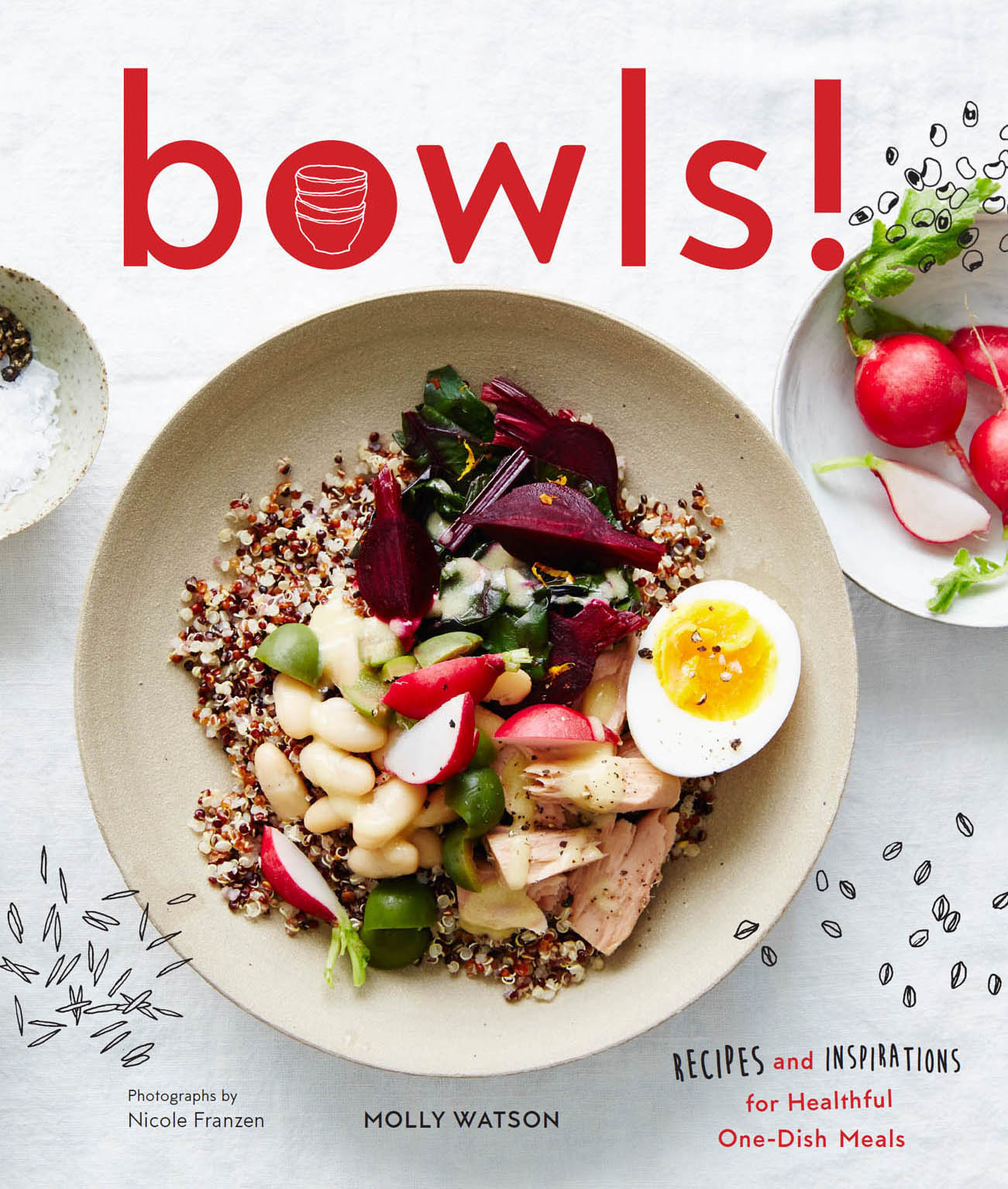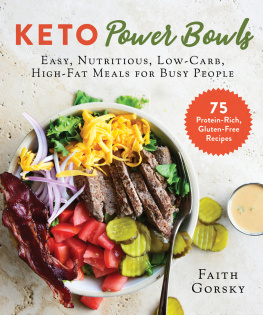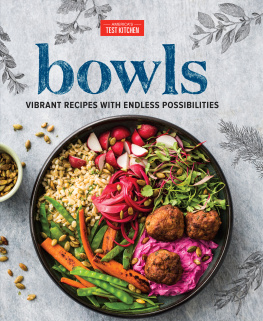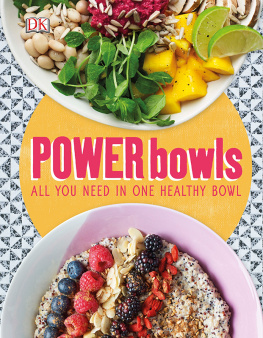


Text copyright 2017 by Molly Watson.
Photographs copyright 2017 by Nicole Franzen.
All rights reserved. No part of this book may be reproduced in any form without written permission from the publisher.
ISBN 978-1-4521-5627-9 (epub, mobi)
Library of Congress Cataloging-in-Publication Data available.
ISBN 978-1-4521-5619-4 (hc)
Designed by Vanessa Dina
Illustrations by Rachel Harrell
Prop styling by Kira Corbin
Food styling by Lillian Kang
Typesetting by Frank Brayton
Chronicle books and gifts are available at special quantity discounts to corporations, professional associations, literacy programs, and other organizations. For details and discount information, please contact our premiums department at corporatesales@chroniclebooks.com or at 1-800-759-0190.
10 9 8 7 6 5 4 3 2 1
Chronicle Books LLC
680 Second Street
San Francisco, California 94107
www.chroniclebooks.com
INTRODUCTION
They are the first to go. The cupboard still holds a tall stack of plates, but the bowls are gone. They are filling the dishwasher, sitting in the sink, or drying on the rack. Well before bowls were in fashion in the food world, we were eating out of them at a furious pace in my house.
We loaded them up with soup and cereal and stew. Snacks of popcorn. Garnish-laden salads. And we used them first because my favorite breakfasts and lunches have long been leftovers from dinner, heated up, plopped in a bowl, and topped with cheese or hot sauce or a dollop of sour cream or a handful of arugulaa final fresh addition to give the leftovers new life.
In short, bowls represent everything you want in a meal: easy to make, tasty to eat, and, more often than not, wonderfully frugal. Best of all, theyre flexible (always flexible!). Add or subtract elements to suit your individual tasteand that of everyone at the table.
Bowls are perfect for weeknight eating, particularly on those evenings when a stop at the store for something specific isnt in the cards. Often as not, you can assemble a delicious bowl from whats hiding in the cupboard or sitting in the fridge. If you have your favorite condiments on hand, they do magic in bringing otherwise disparate foods together.
Case in point: One night while writing up recipes for this book, I took some leftover rice, mixed it with a can of tuna, drizzled on a little chile oil, threw in a handful of chopped celery, and scattered arugula on top. Was it the best bowl Ive ever eaten? I cant say that it was. Would I purposefully make it again? Um, probably not. Was it a tasty and serviceable dinner made from things I found in the kitchen, ready in three minutes, and relatively healthful? Yes it was.
Up ahead youll find provides some appealing combinations that serve as templates or inspiration for throwing those components together into satisfying bowl-based meals.
Watch out, though. Once you get used to bowl-centric eating, you may find yourself turning to this irresistible tableware even when you have time to cook an elaborate supper from scratch. Thats where comes in. It is a culinary goldmine packed with complete, sometimes complex creations.
Whether you turn to a simple lineup of rice, spinach, and eggs or a more elaborate combination, may your bowls be well used.
A NOTE ON SUBSTITUTIONS
Bowls are flexible. Full stop.
A good rule of thumb: if you come across a combination or a recipe for a bowl that sounds good except for one element, its best to substitute like with like. Replace a grain with a grain, meat with meat, cooked vegetable with cooked vegetable, crunchy garnish with crunchy garnish, and so on.
That said, even that constraint may rein too tight. Some of the suggestions in these pages are classic combinations put together in a new bowl-centric way. Ethiopian fasting foods (often served as veggie combos) are thrown in the air to come down transformed in the Addis Ababa Lane Bowl. Chicken paprikash and other Hungarian flavors find themselves piled together in the Budapest Bowl.
Others, however, may well read like random mishmashes. They are and they arent. They are random, but the jumbled nature of bowls is exactly where their charm and power lie. So go forth, put things randomly in bowls, top them with something fresh and tasty, and dig in!
A NOTE ON AMOUNTS
The recipes in this book are for four modest servings, and the yield of any subrecipe assumes the food will be combined with other things in a bowl (or on a plate, if thats how you roll). Increase or decrease amounts according to whos tucking into the bowls around your table.
ABOUT THE ORDER OF OPERATIONS
In , several components are being prepared for each bowl, so I have provided an Order of Operations with each recipe that outlines a plan of attack. Sometimes a recipe can be hurried along by skipping among the elements, such as preparing vegetables and sauces while grains or meats cook. In all cases, the Order of Operations quickly points out the most efficient way to get everything chopped, cooked, and ready to assemble.

PART 1
bowl basics
Building Blocks of a Tasty Bowl
The best bowls have at least one of each of the following elements. That said, feel free to skip one (or two) or use more than one from any given category. Bowls are all about flexibility and personal taste, so do as your taste budsand the contents of your refrigerator and your cupboardsdictate to create bowls that range from simply healthful to over-the-top indulgent.

.

GRAINS & THE LIKE
The most common bases for bowls are rice and quinoa, and multiple ways to cook both of them are included here. Youll find other grains, pseudograins, and noodles here, as well. There is no need to stick to grains as the bases for your bowls, though. Beans and other legumes of all sorts can play that role, too, as can mashed, roasted, or hashed vegetables.
As noted earlier, these recipes yield modest servings for four. You can easily adjust the amounts for larger batches and store the extra for another meal or two. Making a large batch of grains and freezing meal-size portions is a great way to work longer-cooking whole grains into everyday meals.
Barley
3 cups [720 ml] water or broth
1 cup [200 g] pearled barley
1/2 tsp salt (if using water)
In a medium saucepan over high heat, bring the water or broth to a boil. Add the barley and the salt if using water, bring back to a boil, adjust the heat to maintain a steady simmer, and cook, stirring frequently, until the barley is tender, 25 to 30 minutes. If any liquid remains, drain it off. Use immediately, or spread on a baking sheet to cool, then transfer to an airtight container and refrigerate for up to 3 days or freeze for up to 6 months.
Next page












